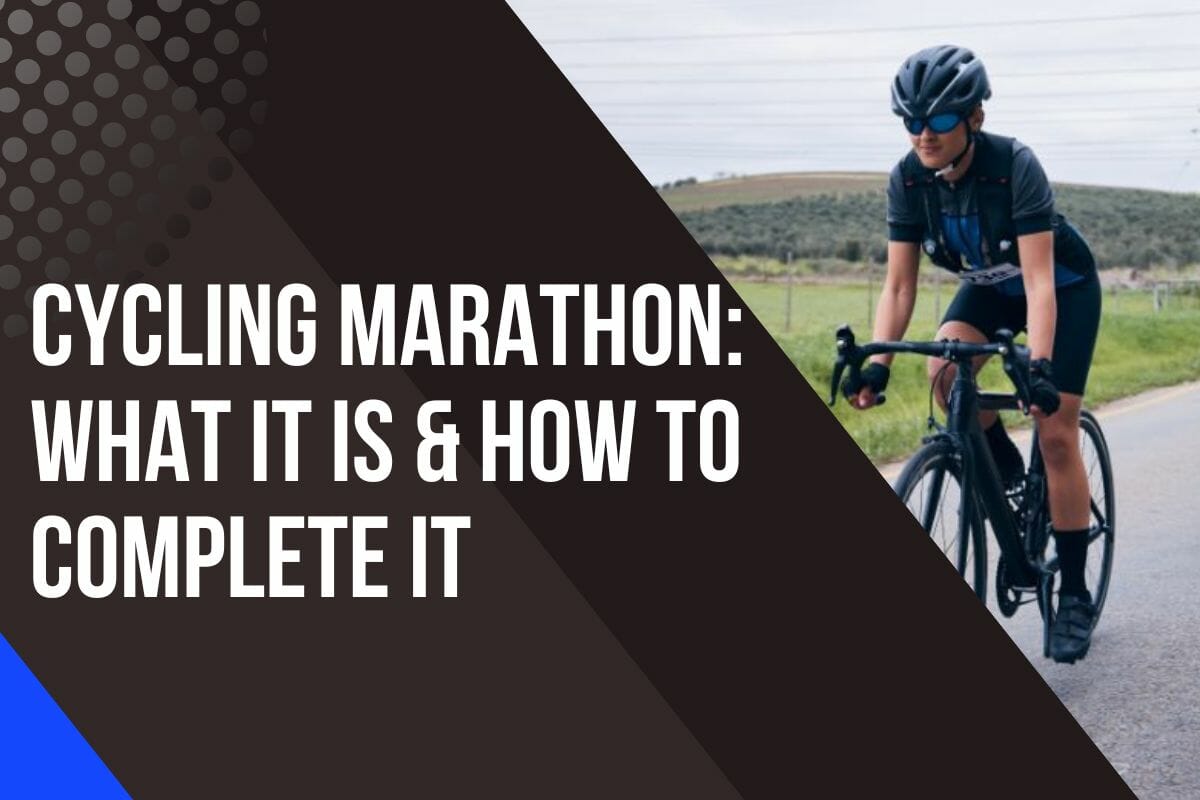Cycling Marathon: What It Is & How To Complete It

Are you ready for a challenge? How about a cycling marathon?
Whether you’re an experienced cyclist or just starting out, a biking marathon can be a great way to push yourself and achieve a new goal.
You’ll also gain mental toughness and a sense of accomplishment.
But before you hit the road, there are some important things to consider to ensure a successful and enjoyable biking marathon.
Here we’ll explore everything you need to know to prepare for a biking marathon, including training and racing tips, and nutrition advice.
What is a Cycling Marathon?
A cycling marathon is a long-distance bike race typically consisting of distances of 50 to 200 miles.
One of the most prestigious cycling events in the world, the Tour de France, features stages that range from 100 to 140 miles.
But cycling marathons aren’t just for the pros, they can also be organized for charity purposes and can range from 10 to 100 miles.

While running a marathon may be the most well-known endurance event, cycling a mile requires much less energy and time than running a mile.
That’s why many people have adopted the concept of the hundred-mile distance as the closest equivalent to a running marathon for cycling events.
Thanks to advancements in technology and training methods, athletes are now pushing themselves to surpass century milestones and achieve even greater feats in racing.
Types of Marathons
Below, we’ll take a closer look at some of the different types of cycling marathons, from century rides to time trial events, and explore what makes each one unique.
There are 4 common types of cycling marathon:
Century Rides
Century Rides have become increasingly popular in the US, with cyclists seeking new challenges and opportunities to push themselves to the limit.
As the name suggests, a Century Ride is a cycling event that requires riders to complete a distance of 100 miles in a single day.
However, some riders go further, taking on 200, 300, or even 400 miles, making this type of event a true test of stamina and endurance.
Century Rides are not for the faint-hearted. They require serious dedication and training. However, if you are up for the challenge, a Century Ride can be a truly rewarding experience.
Ultra-Distance Cycling Races
Ultra-Distance Cycling Races are the ultimate challenge for cycling enthusiasts who crave an adrenaline rush and love pushing themselves to their limits.
These races typically have distances of more than 100 miles and can extend up to 1,200 miles or more in some cases.
What makes these races even more thrilling is that they are usually self-supported, meaning that riders must carry their own food, water, and gear.
And the terrain can be anything from roads and gravel to off-road trails or even snow!
But don’t worry, there are plenty of ultra-distance cycling races held around the world, and some of the most popular ones are listed on websites such as Battistrada and Ride Far.
Participating in an ultra-distance cycling race requires a high level of fitness, endurance, and mental toughness to complete.

But the sense of accomplishment you’ll feel when you cross that finish line is indescribable!
And if you’re really serious about taking on this challenge, you can even aim to be part of the World Ultra Cycling Association (WUCA) Ultra-Distance Challenge.
The WUCA oversees a calendar of ultra events worldwide and computes the average speed of a rider’s two fastest races of at least 500 miles (or 750 km) long.
The most anticipated ultra-distance races are the RAAM (Race Across America) and the Transcontinental Race.
RAAM is one of the longest annual endurance events in the world held annually in June and starts from Oceanside, California, and finishes in Annapolis, Maryland, covering a distance of 3,000 miles in just 12 days.
The Transcontinental Race, held in August, is also a cross-country race, starting from Burgas, Bulgaria, and finishing in Brest, France, covering a distance of 2,500 miles and takes 7 to 10 days to complete. However, each year the routes and distances usually vary.
Cyclocross Races
Cyclocross races are a unique type of marathon biking event that takes cycling to new levels that happens during the cooler months of the year, from October to February.
The races involve multiple laps of a challenging course that includes everything from pavement to wooded trails to steep hills and obstacles that require riders to dismount, carry their bikes, and then quickly remount.
Unlike typical biking races, cyclocross events take place on off-road courses filled with obstacles, steep hills, sharp turns, and varying terrain types.
To come out on top in a cyclocross race, you need a combination of endurance, strength, and technical skills to navigate the challenging course.
Typically, cyclocross races last anywhere from 40 minutes to an hour, with each lap being between 1 and 3 kilometers long.

During this time, riders must complete as many laps as possible, with the rider who completes the most laps being declared the winner.
There are tons of races held all around the world, with some major events listed on the Cyclocross Calendar.
Here in the United States, you can catch cyclocross races from September to February, except in sunnier states like Florida and California where races can happen year-round.
And if you’re looking to get in on the action, check out BikeReg.com – an online cycling event registration website that lists plenty of cyclocross events across the country.
Time Trial Events
Time trial events offer an exhilarating challenge for cyclists seeking to test their limits against time.
Whether it’s a 12 or 24-hour race or an ultra-distance event like RAAM, each competition has its own set of rules and obstacles.
Time Trials require you to race against the clock and the winner is the one with the fastest overall time. Instead of a mass start, riders are assigned start times and are prohibited from drafting, which places a premium on aerodynamics and power production.
But if you’re truly looking to take things to the next level, ultra-distance events are where the real excitement lies.

Lasting for days and spanning mind-boggling distances of up to 3000 miles, these races demand unwavering focus and strategic planning.
It may be an arduous journey, but the feeling of accomplishment is absolutely priceless.
Benefits of Cycling Marathons
Participating in a biking marathon is an amazing way to boost your physical and mental health.
It’s a truly rewarding experience that allows you to push yourself to new limits and discover what you’re truly capable of.
Training for a Marathon
It is important to have a structured training plan to prepare for the physical and mental challenges of a marathon.
Below, we will discuss the essential elements of training for a marathon, including creating a training plan, selecting appropriate gear, incorporating cross-training, and maintaining a balanced diet and recovery plan.
Physical Preparation: Building Endurance and Strength
Physical preparation is essential for anyone looking to tackle a biking marathon.
It requires a comprehensive training program that prepares the body for the physical demands of such an event.
The combination of strength, endurance, and cardiovascular health is crucial in ensuring that the body is in optimal condition come race day.
Regular Cycling Workout
Regular cycling workouts are an important aspect of physical preparation, as they help build endurance and improve cycling efficiency.
Incorporating a variety of workouts that feature hills, sprints, and distance training will provide a well-rounded approach to training.
Strength Training
Strength training is another critical element for a successful biking marathon. Building your strength will help you climb hills, handle the resistance, and cope with long rides.
Strength training can help improve your core, lower back, and leg muscles. You can accomplish this through weightlifting, squats, lunges, and other resistance-training exercises.
Cross-Training
Cross-training is another key component of physical preparation. By engaging in activities such as weight-lifting, yoga, or swimming, one can improve overall fitness and balance in muscle development.
Cross-training is also crucial in ensuring that the body is not overworked and susceptible to injury.

Mental Preparation
Completing a biking marathon is not just about physical preparation, it’s also about mental strength.
You need to have a strong mindset to endure the long and grueling ride. When you start to feel tired and experience pain, mental toughness is what will push you through.
Break It Down Into Chunks
To stay mentally strong during the ride, it’s important to stay laser-focused.
Break down the journey into smaller goals or milestones that you can conquer.
Aim to reach a specific mile marker by a set time or set smaller distance targets.
By achieving these mini-goals, you’ll feel a surge of progress and accomplishment that will fuel your motivation to reach the ultimate finish line.
But it’s not just about the physical aspect, your mindset is crucial.
Picture yourself succeeding, visualize that exhilarating feeling of crossing the finish line.
Keep a positive mindset to stay calm, composed, and confident when the going gets tough.
Remember all the hard work you’ve put in leading up to this moment, and remind yourself that you’ve got what it takes.

Have Your Own Mantra
To get through those challenging moments, having a personalized mantra or motivational phrase can be a powerful tool.
Find a phrase that resonates with you, such as ‘I can do this’ or ‘just keep pedaling,’ and repeat it mentally or out loud to help you stay focused and motivated.
So, gear up and prepare yourself mentally and physically for the biking marathon. With the right mindset, you can conquer any challenge that comes your way and cross that finish line with a sense of pride and accomplishment.
Nutrition and Hydration
To get the most out of your biking marathons, prioritize your nutrition and hydration.
Don’t risk dehydration, especially in the second half of the race, as it can slow your digestion and increase hunger.
Overeating can lead to discomfort and hinder your performance.
The good news is that you can stay hydrated by drinking fluids rich in electrolytes.
Stay ahead of thirst by regularly drinking a combination of water and sports drinks. And don’t forget to fuel your body with the right nutrients.
Carbohydrates are your primary energy source, so consume them before and during the race.
Not sure what to eat? Here I have a list of best pre-ride meals (with videos).
For post-race recovery, prioritize protein-rich foods to repair and rebuild muscle tissue. Stay hydrated and nourished to optimize your biking performance.
Rest Days and Recovery
When it comes to preparing for a biking marathon, your training schedule is undoubtedly filled with challenging rides and demanding workouts.
While it’s important to push yourself to build endurance and improve performance, it’s equally important to incorporate adequate rest days and recovery techniques into your routine.
You need your muscles to recover and rebuild, which ultimately benefits your training.
Not giving your muscles enough time to rest can result in overtraining, leading to injuries, burnout, and decreased performance.
Alongside rest days, utilizing recovery techniques such as stretching, foam rolling, and getting sufficient sleep are essential for muscle recovery and improved performance.
I highly recommend an active recovery, like a leisurely bike ride or yoga class. This aids in increasing blood flow and reducing muscle stiffness without causing excessive stress on your body.
Tips on Completing the Marathon
Completing a cycling marathon is a daunting challenge that requires extensive physical and mental preparation.
Here are some practical steps and tips to help you achieve this feat.
What To Do During Early Stage
It’s easy to get swept away in the excitement of the event, but going all out in the beginning, can spell disaster for your endurance.
To make it to the finish line, you need to pace yourself.
Pacing is the key to success when it comes to endurance events like cycling marathons.
You need to know your limits and hold back just a little bit to conserve your energy for the latter part of the ride.
You don’t want to use up all your energy at the start because you won’t be able to finish the distance.

Don’t get too caught up in the clock and try to be the fastest rider in the first third of the ride.
Remember, it’s about endurance, not speed. If you try to push too hard too soon, you’ll crash and burn before you even get close to the finish line.
Stay focused on your own ride and don’t worry about what others are doing. Find your pace and stick to it, no matter what.
Don’t let the excitement of the event throw you off course.
What To Do In The Middle of the Ride
As we all know, the middle portion of a cycling marathon can be a real uphill battle and it’s all about mental strength.
But with the right mindset, you can conquer those obstacles and ride toward the finish line with ease.
The key is to keep those positive vibes flowing and stay motivated. It’s all too easy to let negative thoughts creep in, like “I can’t finish this” or “This is too hard”.
But shift your focus to the fact that we’ve already tackled half of the ride – you’re more than capable of finishing it. Use your previous hard work as fuel to push through the challenges ahead.
When you hit that 50-mile mark, view the remaining distance as a fresh 50-mile ride. It’s totally doable – you’ve already done it before.

And sure, you may feel some physical and mental fatigue, but do not dwell on it. Instead, think about the incredible sense of accomplishment and pride you’ll feel when you cross that finish line.
Here’s a little secret – unlike running, we can actually coast on our bikes. So take advantage of that and give yourself some brief moments of rest while still keeping that forward momentum.
It’ll help alleviate your fatigue and give your mind a chance to recharge.
Break It Up Into Smaller Milestones
Breaking up the ride into smaller, more manageable chunks can help you stay focused and motivated throughout the entire journey.
But here’s the catch – you need to find the distance that works best for you.
Whether it’s dividing the marathon into 10-mile segments or two 25-mile segments, figuring out what works best can help you optimize your performance and reach your goals.
For instance, if you’re anticipating a 5-hour ride, it may seem daunting to think about riding for such a long stretch.
But if you break it up into one-hour increments, it suddenly becomes much more doable.
So don’t be intimidated by the distance – just take it one chunk at a time and you’ll be cruising along in no time.
Maintain Your Hydration Level
Proper hydration is crucial in any endurance event, but it becomes especially important during the second half of a cycling marathon.
Not drinking enough water can not only affect your performance but also slow down digestion, leading to hunger pangs even after consuming energy gels and food.
To ensure you stay hydrated during the race, experts recommend drinking between 24-30 ounces of water and electrolyte drinks per hour. (1)
However, this may vary depending on your sweat rate and environmental factors like heat and humidity.
Don’t forget to refill your water bottles at aid stations along the way to keep your hydration levels in check.
While energy gels may give you a quick burst of energy, it’s also crucial to eat solid foods for a constant supply of fuel.
Yummy snacks like bananas, granola bars, and peanut butter sandwiches can help you keep going without upsetting your stomach.
And hey, remember to steer clear of caffeine and alcohol the night before and on the day of the event.
What To Do During Final Stage
The final stage of the biking marathon is where the real challenge begins.
After covering a massive distance and conquering tough terrain, this last stretch to the finish line will truly test your limits.
It’s a true measure of your endurance, determination, and mental resilience.
As someone who has registered and trained for this marathon, it’s crucial to prepare yourself mentally and physically for this final stage.

Your body has already used up all its energy, so you must carefully manage your remaining resources.
But don’t worry, the end is in sight, and that can give you the boost you need to tap into your reserves and finish strong.
I can’t stress this enough – The key to success in this stage is your mental strength. Remind yourself of how far you’ve come and how close you are to the finish line.
Take pride in all your accomplishments and let these thoughts motivate you to push beyond your limits.
Find solace in knowing that you’ve emptied the tank and left everything on the course.
So let’s do this! Show yourself what you’re truly capable of and cross that finish line with your head held high.





